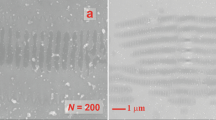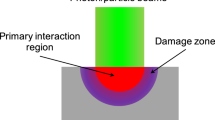Abstract
Nanostructure fabrication on a silicon substrate using a near-field electromagnetic enhancement in the vicinity of gold nanoparticles is studied. Experimental and theoretical investigations are made in order to clarify the properties of the nanoholes produced. The obtained results show that this nanofabrication technique is a flexible method for precise surface nanostructuring. Gold particles with diameters of 40, 80, or 200 nm are placed on the silicon substrate by a spin-coating method, and a 100 fs laser pulse (λ=820 nm) is used to irradiate the samples. A theoretical treatment of the results obtained is made by FDTD (finite difference time domain) simulation and calculations of the near field scattering cross section based on Mie’s theory. The effect of the laser fluence, polarization, and particle size and arrangement on the nanohole properties is studied. The nanohole profiles correspond to the field distributions on the substrate in the low laser fluence region. By using a lower laser fluence than the ablation threshold of bulk silicon, a hole with a diameter of about 40 nm can be produced using a 200 nm gold particle. Furthermore, the gold particles exhibit a considerable field enchantment even at gold particle sizes of a few tens of nanometers, which offers a good opportunity for further decreases in the size of the produced structures. A highest electric field enhancement factor of about 26 is obtained for particles with a diameter of 200 nm. With the decrease of the particle size the field enhancement also decreases. Particle arrangement on the substrate surface strongly affects both the electric field distribution and the enhancement effect of the particles. The highest enhancement for a particle pair is obtained when the polarization of the incident radiation is parallel to the pair axis (longitudinal mode). A good correlation is obtained between the near-field distribution predicted by FDTD simulation and the parameters of the experimentally produced nanoholes.
Similar content being viewed by others
References
S.M. Huang, M.H. Hong, B. Lukiyanchuk, T.C. Chong, Appl. Phys. A 77, 293 (2003)
Z.B. Wang, M.H. Hong, B.S. Luk’yanchuk, Y. Lin, Q.F. Wang, T.C. Chong, J. Appl. Phys. 96, 6845 (2004)
M. Mosbacher, H.-J. Münzer, J. Zimmermann, J. Solis, J. Boneberg, P. Leiderer, Appl. Phys. A 72, 41 (2001)
H. Takada, M. Obara, Japan J. Appl. Phys. 44, 7993 (2005)
U. Kreibig, M. Vollmer (Eds.), Optical Properties of Metal Clusters (Springer, Berlin, 1995)
S.M. Huang, M.H. Hong. B. Luk’yanchuk, T.C. Chong, Appl. Phys. Lett. 82, 4809 (2003)
P. Leiderer, C. Bartels, J. König-Birk, M. Mosbacher, J. Boneberg, Appl. Phys. Lett. 85, 5370 (2004)
N.K. Grady, N.J. Halas, P. Nordlander, Chem. Phys. Lett. 399, 167 (2004)
I. P.-Santos, D. Gomez, J. Perez-Juste, L.M. Liz-Marzan, P. Mulvaney, Phys. Chem. Chem. Phys. 6, 5056 (2004)
I. Notingher, A. Elfick, J. Phys. Chem B 109, 15699 (2005)
A. Taflove, S.C. Hagness, Computational Electrodynamics: The Finite-Difference Time-Domain Method (Artech House, Boston, 2000)
K. Sendur, W. Challener, C. Peng, J. Appl. Phys. 96, 2743 (2004)
A. Vial, A.S. Grimault, D. Macías, D. Barchiesi, M.L. Chapelle, Phys. Rev. B 71, 085416 (2005)
B.J. Messinger, K. Ulrich von Raben, R.K. Chang, P.W. Barber, Phys. Rev. B 24, 649 (1981)
M. Quinten, Appl. Phys. B 73, 245 (2001)
P.B. Johnson, R.W. Christy, Phys. Rev. B 6, 4370 (1972)
H.-J. Münzer, M. Mosbacher, M. Bertsch, J. Zimmermann, P. Leiderer, J. Boneberg, J. Microsc. 202, 129 (2001)
J.T. Krug II, E.J. Sanchez, X. Sunny Xie, J. Chem. Phys. 116, 10895 (2002)
M. Quinten, Z. Phys. D 35, 217 (1995)
M. Quinten, Appl. Phys. B 70, 579 (2000)
Author information
Authors and Affiliations
Corresponding author
Additional information
PACS
42.62.-b; 52.38.Mf; 81.65.Cf; 81.16.-c; 78.67.Bf
Rights and permissions
About this article
Cite this article
Nedyalkov, N., Takada, H. & Obara, M. Nanostructuring of silicon surface by femtosecond laser pulse mediated with enhanced near-field of gold nanoparticles. Appl. Phys. A 85, 163–168 (2006). https://doi.org/10.1007/s00339-006-3679-9
Received:
Accepted:
Published:
Issue Date:
DOI: https://doi.org/10.1007/s00339-006-3679-9




